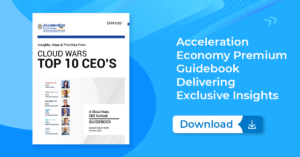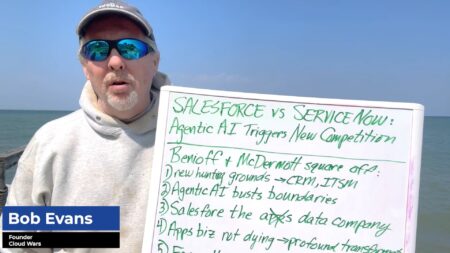
While the investor class took Oracle to the woodshed over Q1 results and stripped about $35 billion out of its market cap in a single day, customers continue to exhibit great confidence in Oracle’s cloud business as Oracle retains its status as the world’s fastest-growing major cloud provider.
During the Sept. 11 call, Oracle CEO Safra Catz indirectly conceded that some observers might look at the Q1 numbers as an indication that Oracle’s high-growth days might be ending when she noted that “in any quarter there may be fluctuations.”
But both Catz and chairman Larry Ellison have always been astute participants in the long game, and Catz offered a few perspectives to buttress her belief that customer demand for Oracle Cloud remains extremely strong. Let me share those and then offer a couple of broad comments from Ellison that reveal why he also remains completely bullish on Oracle’s position in spite of the 24-hour stock-market thrashing that slashed Ellison’s personal net worth by several billion dollars.
Safra Catz: ‘Extremely Confident About Revenue Acceleration’
But first, here’s CEO Catz:
- “The level of demand we have is stunning. Stunning is the only word I can use. And I don’t want to get overly exuberant, simply because we do have to continue to build out our systems, etc.”
- “Per my earlier remarks, we have a great line of sight into the trajectory of the business given the bookings momentum. We are extremely confident about our revenue acceleration for the year, even though in any quarter there may be small fluctuations.”
- “Because we have far more demand than we can supply, our biggest challenge is building data centers as quickly as possible.”
- “We are in an accelerated transition of Cerner to the cloud. This transition is resulting in some near-term headwinds to the Cerner growth rate as customers move from license purchases, which are recognized up-front, to cloud subscriptions, which are recognized ratably.”
- “I remain committed to accelerating our total revenue growth rate this fiscal year as well as maintaining our current high cloud growth rate for the year.”
- “As you will hear at our Financial Analyst Meeting next week, we remain firmly committed to our fiscal-2026 financial goals.”
While it’s the job of every CEO to make a positive case for her or his company, those don’t sound to me like the words of a leader whose company has peaked. And the Q1 cloud numbers that I’ll share in a moment underscore not only the confidence expressed by Catz but also my belief that Oracle will remain the world’s hottest major cloud provider at least through the end of this year. For more on that, please see my analysis posted the eight hours before Oracle released its Q1 numbers: “Oracle Q1 Preview: Will Remain Fastest-Growing Major Cloud Vendor.”
How Larry Ellison Sees It
So first a few excerpts from Ellison’s commentary on the Q1 earnings call, and then I’ll share key cloud results from Q1:
- “As of today, AI development companies have signed contracts to purchase more than $4 billion of AI training capacity in Oracle’s Generation 2 Cloud. That’s twice as much AI training as we had booked at the end of Q4.”
- “The largest AI technology companies and the leading AI start-ups continue to expand their business with Oracle for one simple reason: Oracle’s RDMA-interconnected NVIDIA Superclusters train AI models at twice the speed and much less than half the cost of other clouds.”
- “Our Cloud Applications business is doing quite well, and it’s about to get even better. In the current quarter, we expect our Cerner health business to be awarded two large new contracts with a total value of over $1 billion.”
- “AI doesn’t work without getting access to and ingesting enormous amounts of data. So, in terms of a shift away from data or a change in gravities at AI, AI is utterly dependent upon vast amounts of training data. Trillions of elements went into building ChatGPT 3.5, and multiple times that for ChatGPT 4.0 because you had to deal with all the image data and ingest all of that to train image recognition. So we think this is very good for our Database business and Oracle’s new vector database will contain highly specialized training data like electronic health records, while keeping that data anonymized and private, yet still training the specialized models that can help doctors improve their diagnostic capability and their treatment prescriptions for cancer and heart disease and all sorts of other diseases.
- “So we think it’s a boon to our business and we are now getting into the deep water of the information age. Nothing has changed about that. The demands on data are getting stronger and more important.”
- “The back office in the cloud is very different than the back office on-premise, and we have a big advantage that we are by far and away the biggest — I don’t know, 95% of the cloud ERP market — in terms of actual live customers using it.”
- “So what is B2B e-commerce between two Oracle ERP Cloud customers? It’s one Oracle Procurement system talking to another Oracle Order Management system and financing the transaction through their bank. We automate that entirely in the cloud. If your bank is JPMorgan Chase, they originate the loan right along with your purchase. It’s e-commerce for B2B with banking and shipping and insurance, all included and rolled together.”
- “We’ve done a great job as an industry automating e-commerce for B2C. I mean, Amazon, Walmart, others have done a brilliant job in that, and have been doing that for a long time. We have not got the equivalent in B2B commerce because B2B transactions are much more complex. In the cloud, you can get all the parties together. The shippers, the insurance company, the manufacturers, the purchasers, and we can automate that entirely within the Oracle Cloud.”
Key Q1 Cloud Numbers
Here are several key cloud-revenue results released by Oracle for its fiscal quarter ended Aug. 31:
- total cloud: $4.6 billion, up 30%;
- cloud infrastructure: $1.5 billion, up 66%;
- cloud apps: $3.1 billion, up 17%;
- within that apps total, Fusion Cloud ERP: $800 million, up 21%; and
- also within that apps total, NetSuite Cloud ERP: $700 million, up 21%.
Final Thought
I was surprised to see that the growth rate for total cloud-apps revenue was just 17% — that’s well below past performances. So in three months when Oracle releases fiscal-Q2 numbers for the quarter ending Nov. 30, I’ll be keeping a very close eye on that specific figure to see if it was indeed just a “fluctuation” or if it should be regarded as a trend.
Gain insight into the way Bob Evans builds and updates the Cloud Wars Top 10 ranking, as well as how C-suite executives use the list to inform strategic cloud purchase decisions. That’s available exclusively through the Acceleration Economy Cloud Wars Top 10 Course.










